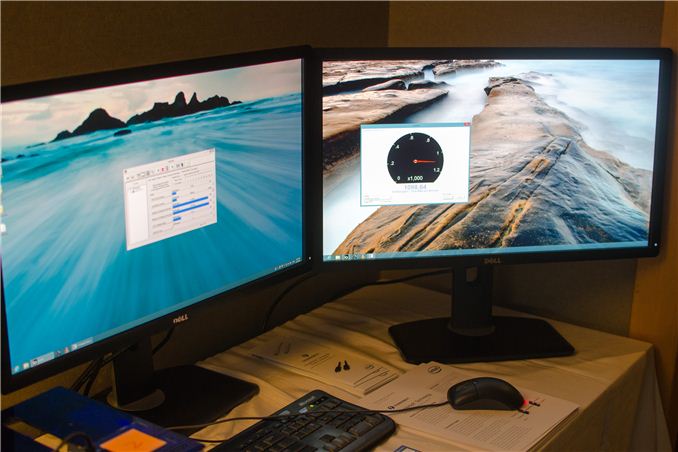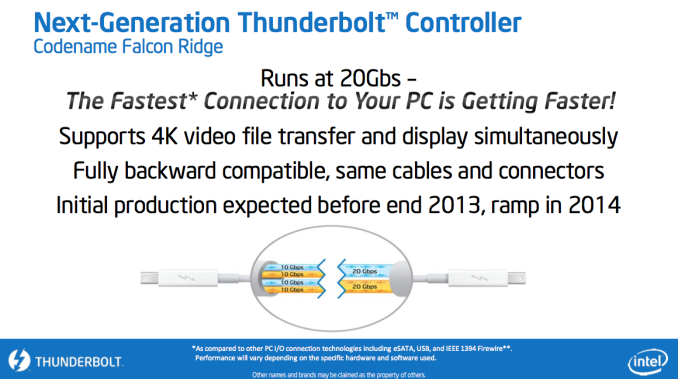Intel's Thunderbolt 2: Everything You Need to Know
by Anand Lal Shimpi on June 9, 2013 8:39 PM EST- Posted in
- Storage
- CPUs
- Intel
- Thunderbolt

At Computex, Intel officially branded its next-generation Thunderbolt as Thunderbolt 2. As a recap, current Ivy Bridge platforms use Cactus Ridge Thunderbolt controllers while newly launched Haswell platforms use Redwood Ridge. Redwood Ridge maintains feature compatibility, but you get official support for DisplayPort 1.2 (and 4K resolution) if you're using a DisplayPort monitor. This extension of DP 1.2 support does not apply to Thunderbolt displays or DP 1.2 displays connected to a Thunderbolt chain however. The explanation is simple. Redwood Ridge won't be sold for use in devices, only host computers, which is why you can't plug a 4K DP 1.2 display into a Thunderbolt chain and have it work (since none of the members of the chain will support 4K passthrough).
Falcon Ridge however is designed to address this problem later this year. Falcon Ridge will officially be the first controller to implement Thunderbolt 2. Despite the increment in nomenclature, the differences are actually pretty simple.
Today, Thunderbolt exists as four 10Gbps channels - two upstream and two downstream. Each channel however is fully independent. Although PCIe and DisplayPort are muxed from the cable perspective, you can only send one or the other over each channel. That limits max performance for a single storage device to 10Gbps (minus overhead), and it similarly limits the max display bandwidth to 10Gbps as well. The latter is insufficient for 4K video (~15Gbps depending on refresh rate). If you bypass Thunderbolt and just send DP 1.2 over the cable it's not a problem, but if you want to enable mixed use cases where you're driving both 4K video and high-speed storage over the same cable you're going to need another solution.
Thunderbolt 2 provides that solution. By combining the channels together, Thunderbolt 2 enables two 20Gbps bi-direction channels instead of two sets of 10Gbps channels. There's no overall increase in bandwidth, but the solution is now more capable. Since there's 20Gbps of bandwidth per channel, you can now do 4K video over Thunderbolt. You can also expect to see higher max transfer rates for storage. Whereas most Thunderbolt storage devices top out at 800 - 900MB/s, Thunderbolt 2 should raise that to around 1500MB/s (overhead and PCIe limits will stop you from getting anywhere near the max spec).
Intel put together a quick demo of Thunderbolt 2 silicon in one of its suites at Computex. The setup involved two Intel SSD 910s running over Thunderbolt 2 alongside two 2560 x 1440 panels. Peak performance to the SSD array was just under 1100MB/s, which Intel expects will be much higher once final hardware is ready.

The box above basically houses Falcon Ridge silicon (card on the right), connected to a board that distributes PCIe from that controller.
Thunderbolt 2/Falcon Ridge still feed off of the same x4 PCIe 2.0 interface as the previous generation designs. Backwards compatibility is also maintained with existing Thunderbolt devices since the underlying architecture doesn't really change.
I had higher hopes for what Thunderbolt 2 would be (moving to PCIe Gen 3 for example), but it looks like the spec is primarily designed around enabling 4K as well as incrementally increasing storage performance. I'm still holding out for the dramatic changes to usage models though, e.g. enabling external dGPUs over Thunderbolt, but it looks like I'll have to hold out for longer.











34 Comments
View All Comments
tipoo - Sunday, June 9, 2013 - link
I wonder, did current external GPUs utilise the two up and two down channels well? Which is to ask, could there still be a benefit to them even though the aggregate bandwidth is entirely unchanged?Khenglish - Monday, June 10, 2013 - link
No, current eGPU products cannot use more than 1 channel. The bplus adapter that was commonly used until mysteriously recalled (it worked fine. most people refused to return it) only negotiated an x2 2.0 connection, although a TB channel had a little more room, which the sonnet adapter did actually use (at 5x the price) . TB 2 should allow double the bandwidth to a graphics card.Hopefully someone will actually make a reasonably priced adapter.
Kevin G - Monday, June 10, 2013 - link
This just seems like sidestep than a real upgrade. Overall bandwidth doesn't change: four 10 Gbit/s channel to two 20 Gbit/s channels. I was under the impression that Thunderbolt could multiplex two 10 Gbit/s, three 10 GBit/s or all four 10 Gbit/s channels dynamically based upon load. 4k display output should have been possible under current connectivity. In fact, with 40 Gbit/s of bandwidth, 8192 x 4320 at 24 bit color and 30 Hz refresh rate should be possible. So this only enables vanilla DP 1.2 pass through to non-Thunderbolt devices.Ultimately Thunderbolt 2 should have doubled bandwidth per lane for 80 Gbit/s total bandwidth.
repoman27 - Monday, June 10, 2013 - link
Well, the reality is that while Intel could currently bump the lane rate to 14 Gbit/s with existing technology, more than that would require some new magic. The first experimental chips that can support 20+ Gbit/s are just being taped out now.Thunderbolt links only contain 4 simplex lanes, so the maximum achievable bandwidth at the 10 Gbit/s lane rate is 20 Gbit/s, full-duplex. When operating in DisplayPort signaling mode, the 4 lanes form a single simplex DisplayPort main link with a lane rate of 2.16 Gbit/s (after deducting 8b/10b encoding overhead), or, in the case of Redwood/Falcon Ridge, up to 4.32 Gbit/s. This works out to 8.64 or 17.28 Gbit/s per link. DP 1.2 at 17.28 Gbit/s is the highest bandwidth digital display source currently available, but it is still not enough for 8K over a single link.
4K output is possible with current generations of Thunderbolt, just not over a single cable. Since all but the newest 4K displays lack DP 1.2 support and instead rely on 2x DP 1.1a (or multiple DVI/HDMI) links, it's really not much of an issue.
Jaybus - Tuesday, June 11, 2013 - link
It isn't possible to just keep cranking up the lane rate over copper, certainly not without making the cables shorter. It will require an optical cable. The current optical cable has embedded converter and detector, but is expensive and still has to use a copper run from TB controller to the optical transmitter/receiver embedded in the cable.The breakout in lane speed will not happen until the optical components are directly embedded so that the TB controller itself takes optical input/output, an idea they are calling "silicon photonics". Avalanche photodiode detectors as well as lenses, waveguides, and other optical components can already be made using CMOS. The missing component is the light source, or at least a cheap light source that can be implemented in CMOS. It requires an extra layer of a material with suitable optical properties be bonded or embedded to the wafer. A company called Skorpios Technologies has demonstrated a CMOS process for embedding the material. The tech is not there yet, but it is getting close.
Also, the ability to have embedded optical i/o is a significant paradigm shift. The optical signal is capable of higher bandwidth than the current on-chip buses. TB is just an extension of the PCIe bus. But in addition, it is also possible to replace the slow copper memory bus, or any other chip-to-chip i/o. For example, if a DRAM chips can be linked to the CPU/GPU optically, then there is no need for L3 cache and all of that die area used for cache can be re-tasked for more cores or removed to save power and allow smaller (and so higher yield) dies.
HisDivineOrder - Monday, June 10, 2013 - link
Thunderbolt has failed to make any traction and changes like this aren't going to change that. I think we can call it what it is. Thunderbolt is today's firewire.8steve8 - Monday, June 10, 2013 - link
does this mean new MBA has Redwood Ridge?R3MF - Wednesday, June 12, 2013 - link
agreed, the amd alternative is much more interesting, if only because its openness makes it the modern day USB to thunderbolts 'firewire'.tygrus - Tuesday, June 11, 2013 - link
It doesn't double overall bandwidth. The only change is to enable a dual-channel mode for single use devices. This re-allocates existing bandwidth, hardly worth hearing.BlackBamba - Tuesday, June 11, 2013 - link
External Graphics can be used in Laptops while driving the monitor of the laptop or any other locations. Also, the main issue the the Sudden Removal of the cable while 3D is running or even when nothing is running - as a device with "disappear from Windows".Just see the solution here : https://www.youtube.com/watch?v=-AYypyF1SRg